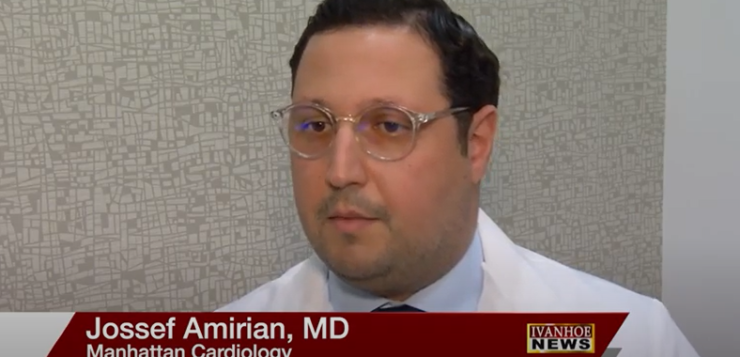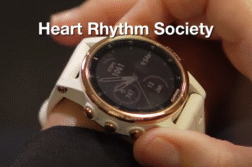Jossef Amirian, MD, Board-Certified Cardiologist at Manhattan Cardiology, talks about how an at home device has revolutionized the way we detect and treat certain heart conditions, specifically atrial fibrillation.
Interview conducted by Ivanhoe Broadcast News in November 2021.
What is atrial fibrillation and what’s happening in that person’s heart?
DR AMIRIAN: Atrial fibrillation is an abnormal heart rhythm, which leads to an increased risk of stroke, approximately five times higher on average. It can also lead to heart failure and blood clots, better known as a venous thromboembolism.
Because of the higher risk of stroke, how important is it that patients identify it and then get it treated?
DR AMIRIAN: Early detection and treatment of atrial fibrillation saves lives. Often, patient’s present in a myriad of ways so we want people to seek care when they feel that something may not feel right. Not everyone presents with the same complaints. One may complain of heart palpitations which is best described as a heart racing sensation. Others may present with dizziness or shortness of breath.
If it’s not treated, what can happen?
DR AMIRIAN: When atrial fibrillation goes untreated, patients can have a stroke that can be debilitating and/or life-threatening. So, it is extremely important that they seek care and get the proper treatment they need right away.
Could you talk through what options are out there for patients?
DR AMIRIAN: When we talk about treatment for atrial fibrillation, we focus on three components – treating the heart rate, treating the heart rhythm and preventing stroke. The heart rate is often treated with medications. The heart rhythm can often be treated with medications or more commonly via a procedure called an ablation, performed by an electrophysiologist. Stroke prevention is often achieved via medications such as blood thinners, specifically anticoagulants or antiplatelet agents and there are procedures focused on preventing stroke as well which focus on closure of a specific area of the heart where clots form called the left atrial appendage.
Is it possible a patient can have this without feeling any symptoms? How frequent is it that atrial fibrillation is happening, and people don’t know?
DR AMIRIAN: That is a great question. Patients can often be asymptomatic. If they do present with symptoms, they can present with heart racing sensations, dizziness, lightheadedness, chest sensations such as chest pain, shortness of breath and dyspnea on exertion, among other symptoms. For some patients, they may have had a stroke in the past but the underlying cause was never determined, and thus atrial fibrillation should be considered in these patients as well.
Can you explain the monitor, Bioflux? What is it and how does it work?
DR AMIRIAN: The Bioflux is a heart rhythm monitor, which detects a patient’s heart rate and rhythm and looks for abnormalities. It has three leads which sit on the patient’s chest via three stickers, which connect to the device. The wires are discrete and are placed under a patient’s clothes. The patient wears the device for four days and nights. They take it off for showering and reapply it after they dry. It monitors the heart rate and rhythm over that four-day span. If there are any abnormalities, the Bioflux detects them and alerts the providing doctor so that the doctor can reach out to the patient right away.
How quickly do doctors know there’s something wrong with their patient?
DR AMIRIAN: The Bioflux can pick up urgent and emergent heart rhythms and alert the providing doctor right away so that they can reach out to the patient and provide them the care they need in a timely fashion. Every second counts as it relates to the heart rhythm, depending on the abnormality. Picking up that abnormal rhythm is extremely important because it can completely change the outlook in the management of a patient, which can make all the difference.
Does the transmission go right to the doctor’s office or cell phone?
DR AMIRIAN: There is a portal which the providers are plugged into, and the heart rhythm is transmitted into the portal. Alerts are sent out either via a phone call or via email to the providers so that they know right away what is going on and can act accordingly.
Does this compare to anything you’ve had before to try to monitor some of your patients?
DR AMIRIAN: I really think it is cutting edge and brand new as it relates to how excellent the device is in detecting arrhythmias and how it gets the information to the portal and to the provider right away.
How sensitive is it?
DR AMIRIAN: It is a very accurate device. It does a great job in looking for the abnormal rhythms.
Is it like a home sleep study in some ways, only the device is picking up information without having to put a patient in the lab to monitor?
DR AMIRIAN: Absolutely. Remote monitoring or monitoring from home is extremely important, especially now throughout this pandemic. Home monitoring is key. This device allows us to monitor a patient’s heart rate and rhythm from home and allows us to provide them the care they need without necessarily having them come into the office. That is extremely important with everything going on right now.
Can you speak to me a little bit about Michel’s case? What was going on with him and why did you suggest the Bioflux?
DR AMIRIAN: In the case of Michel, he was having symptoms of a heart racing sensation and he just did not feel like himself. He did the right thing and listened to his body. He came to us for his care. We gave him this heart monitor and soon after, I received an alert. I reached out to him right away and was able to get him the care he needed and the treatment he needed right away. That made all the difference.
What was that treatment?
DR AMIRIAN: We promptly started him on medications and he ended up having an ablation which helped to relieve him of this abnormal heart rhythm. Since then, he has been in a normal rhythm and he has felt much better.
If he hadn’t had the Bioflux on, how long could he have gone without someone detecting he was in trouble?
DR AMIRIAN: That is a great question. Sometimes patients can alternate between a normal rhythm and an abnormal rhythm. The great thing about the monitor is that it allows us to monitor your heart rate and rhythm over a four-day span. For many patients, that prolonged/multi-day monitoring makes a major difference because it often gives us adequate time to find the abnormality so that we can treat it accordingly.
END OF INTERVIEW
This information is intended for additional research purposes only. It is not to be used as a prescription or advice from Ivanhoe Broadcast News, Inc. or any medical professional interviewed. Ivanhoe Broadcast News, Inc. assumes no responsibility for the depth or accuracy of physician statements. Procedures or medicines apply to different people and medical factors; always consult your physician on medical matters.
If you would like more information, please contact:
Erica Fiorini, PhD
Erica.fiorini@russopartnersllc.com
Sign up for a free weekly e-mail on Medical Breakthroughs called First to Know by clicking here




